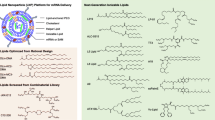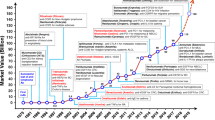Abstract
Type IV collagenase plays a pivotal role in invasion, metastasis and angiogenesis of tumor. Single domain antibodies are attractive as tumor-targeting vehicle because of their much smaller size compared with antibody molecules produced by conventional methods. Lidamycin (LDM) is a potent enediyne-containing antitumor antibiotic. In this study an engineered and energized fusion protein VL-LDP-AE composed of lidamycin and VL domain of mAb 3G11 directed against type IV collagenase was prepared using a novel two-step method. First a VL-LDP fusion protein was constructed by DNA recombination. Secondly VL-LDP-AE was obtained by molecular reconstitution. In MTT assay, VL-LDP-AE showed potent cytotoxicity to HT-1080 cells and KB cells with IC 50 values of 8.55×10−12 and 1.70×10−11 mol/L, respectively. VL-LDP-AE showed antiangiogenic activity in chick chrorioallantoic membrane (CAM) assay and tube formation assay. In in vivo experiments, VL-LDP-AE was proved to be more effective than free LDM against the growth of subcutaneously transplanted hepatoma 22 in mice. Drugs were given intravenously on day 3 and 10 after tumor transplantation. Compared in terms of maximal tolerated doses, VL-LDP-AE at 0.25 mg/kg suppressed the tumor growth by 89.5%, LDM at 0.05 mg/kg by 69.9%, and mitomycin at 1 mg/kg by 35%. Having a molecular weight of 25.2 kDa, VL-LDP-AE was much smaller than other reported antibody-based drugs. The results suggested that VL-LDP-AE would be a promising candidate for tumor targeting therapy. And the 2-step approach could serve as a new technology platform for making a series of highly potent engineered antibody-based drugs for a variety of cancers.
Similar content being viewed by others
References
Cortez-Retamozo V, Lauwereys M, Hassanzadeh Gh G, et al. Efficient tumor targeting by single-domain antibody fragments of camels. Int J Cancer, 2002, 98(3): 456–462
Holliger P, Hudson P J. Engineered antibody fragments and the rise of single domains. Nat Biotechnol, 2005, 23: 1126–1136
Schlereth B, Fichtner I, Lorenczewski G, et al. Eradication of tumors from a human colon cancer cell line and from ovarian cancer metastases in immunodeficient mice by a single-chain Ep-CAM-/CD3-bispecific antibody construct. Cancer Res, 2005, 65(7): 2882–2889
Haas C, Lulei M, Fournier P, et al. T-cell triggering by CD3-and CD28-binding molecules linked to a human virus-modified tumor cell vaccine. Vaccine, 2005, 23(19): 2439–2453
Fang M, Jiang X, Yang Z, et al. Effects of interlinker sequences on the biological properties of bispecific single-chain antibodies. Chin Sci Bull (in Chinese), 2003, 48(18): 1912–1918
Bang S, Nagata S, Onda M, et al. HA22 (R490A) is a recombinant immunotoxin with increased antitum or activity without an increase in animal toxicity. Clin Cancer Res, 2005, 11(4): 1545–1550
Sharma S K, Pedley R B, Bhatia J, et al. Sustained tumor regression of human colorectal cancer xenografts using a multifunctional mannosylated fusion protein in antibody-directed enzyme prodrug therapy. Clin Cancer Res, 2005, 11: 814–825
Ward E S, Gussow W, Griffiths A D, et al. Binding activities of a repertoire of single immunoglobulin variable domains secreted from Escherichia coli. Nature, 1989, 341: 544–546
Saerens D, Kinne J, Bosmans E, et al. Single domain antibodies derived from dromedary lymph node and peripheral blood lymphocytes sensing conformational variants of prostate-specific antigen. J Biol Chem, 2004, 279(50): 51965–51972
Cortez-Retamozo V, Backmann N, Senter P D, et al. Efficient cancer therapy with a nanobody-based conjugate. Cancer Res, 2004, 64(8): 2853–2857
Hu J L, Xue Y C, Xie M Y, et al. A new macromolecular antitumor antibiotic, C-1027. I. Discovery, taxonomy of producing organism, fermentation and biological activity. J Antibiot (Tokyo), 1988, 41: 1575–1579
Zhen Y S, Ming X Y, Yu B. A new macromolecular antitumor antibiotic, C-1027 III. Antitumor activity. J Antibiot, 1989, 42: 1294–1298
Xu Y J, Li D D, Zhen Y S. Mode of action of C-1027, a new macromolecular antitumor antibiotic with highly potent cytotoxicity, on human hepatoma BEL-7402 cells. Cancer Chemother Pharmacol, 1990, 27: 41–46
Huang Y H, Shang B Y, Zhen Y S. Antitumor efficacy of lidamycin on hepatoma and active moiety of its molecule. World J Gastroenterol, 2005, 11: 3980–3984
Wang F Q, Shang B Y, Zhen Y S. Antitumor effects of molecule-downsized imunoconjugate composed of lidamycin and Fab’fragment of monoclonal antibody directed against type IV collagenase. Sci China Ser C-Life Sci, 2004, 47(1): 66–73
Li L, Huang Y H, Li Y, et al. Antitumor activity of anti-type IV collagenase monoclonal antibody and its lidamycin conjugate against colon carcinoma. World J Gastroenterol, 2005, 11: 4478–4483
Wang F Q, Shang B Y, Zhen Y S. Antitumor effects of the immunoconjugate composed of lidamycin and monoclonal antibody 3G11. Acta Pharm Sin (in Chinese), 2003, 38(7): 515–519
Tanaka T, Fukuda-Ishisaka S, Hirama M, et al. Solution structures of C-1027 apoprotein and its complex with the aromatized chromophore. J Mol Biol, 2001, 309: 267–283
Turpeenniemi-Hujanen T. Gelatinases (MMP-2 and-9) and their natural inhibitors as prognostic indicators in solid cancers. Biochimie, 2005, 87: 287–297
Tsumoto K, Shinoki K, Kondo H, et al. Highly efficient recovery of functional single-chain Fv fragments from inclusion bodies overexpressed in Escherichia coli by controlled introduction of oxidizing reagent — Application to a human single-chain Fv fragment. J Immunol Methods, 1998, 219: 119–129
Brinkmann U, Lee B K, Pastan I. Recombinant immunotoxins containing the VH or VL domain of monoclonal antibody B3 fused to Pseudomonas exotoxin. J Immunol, 1993, 150(7): 2774–82
Dubnovitsky A P, Kravchuk Z I, Chumanevich A A, et al. Expression, refolding, and ferritin-binding activity of the isolated VL-domain of monoclonal antibody F11. Biochemistry, 2000, 65(9): 1011–1018
Martsev S P, Tsybovsky Y I, Stremovskiy O A, et al. Fusion of the antiferritin antibody VL domain to barnase results in enhanced solubility and altered pH stability. Protein Eng Des Sel, 2004, 17: 85–93
Coulon S, Pellequer J L, Blachere T, et al. Functional characterization of an anti-estradiol antibody by site-directed mutagenesis and molecular modeling: Modulation of binding properties and prominent role of the VL domain in estradiol recognition. J Mol Recognit, 2002, 15: 6–18
Beucken T, Neer M, Sablon E, et al. Building novel binding ligands to B7.1 and B7.2 based on human antibody single variable light chain domains. J Mol Biol, 2001, 310: 591–601
Wang J L, Zheng Y L, Wang B L, et al. Construction and activity analysis of a recombinant immunotoxin composed of PE38 and a disulfide stable single-chain antibody. Chin J Cell Mol Immun (in Chinese), 2006, 22(1): 74–77
Pastan I, Hassan R, Fitzgerald D J, et al. Immunotoxin therapy of cancer. Nat Rev Cancer, 2006, 6(7): 559–565
Trail P A, King H D, Dubowchik G M. Monoclonal antibody drug immunoconjugates for targeted treatment of cancer. Cancer Immunol Immunother, 2003, 52(5): 328–337
Author information
Authors and Affiliations
Corresponding author
Additional information
Supported by the National High Technology Research and Development Program of China (863 Program)(Grant No. 2006AA02A255)
Rights and permissions
About this article
Cite this article
Miao, Q., Shang, B., Ouyang, Z. et al. Generation and antitumor effects of an engineered and energized fusion protein VL-LDP-AE composed of single-domain antibody and lidamycin. SCI CHINA SER C 50, 447–456 (2007). https://doi.org/10.1007/s11427-007-0058-5
Received:
Accepted:
Issue Date:
DOI: https://doi.org/10.1007/s11427-007-0058-5




